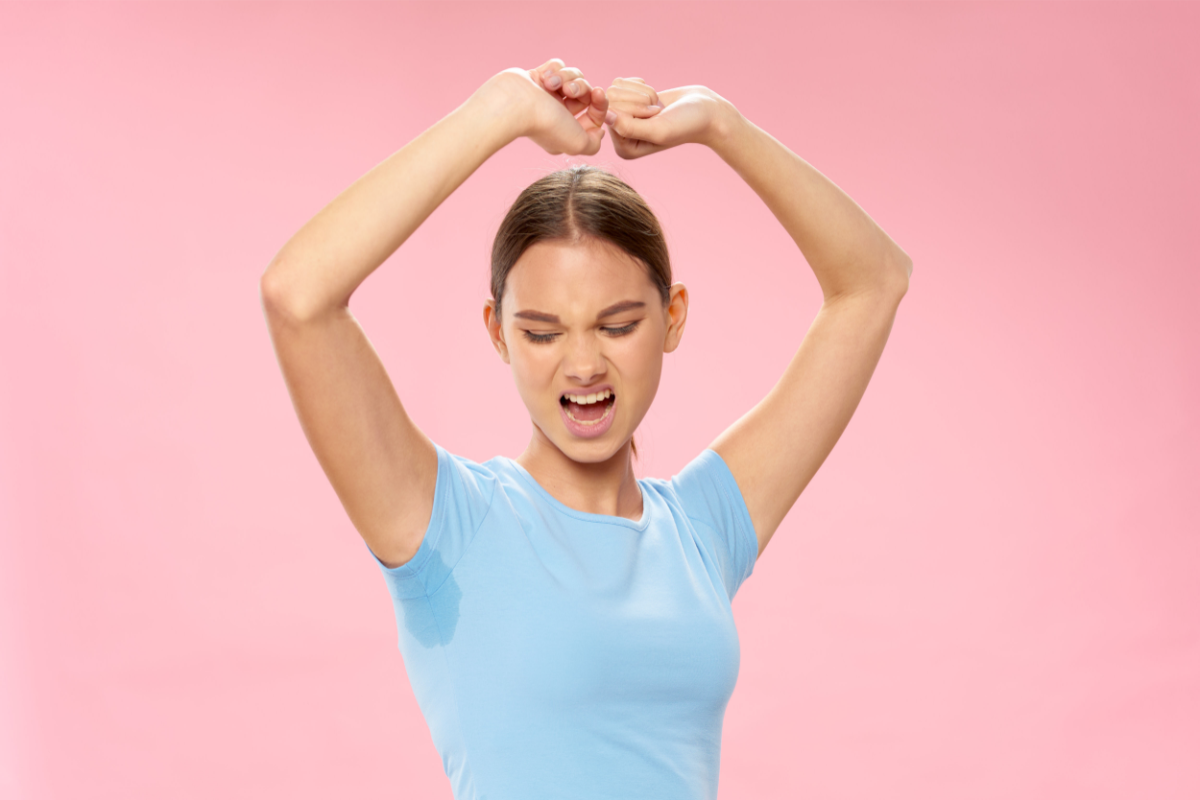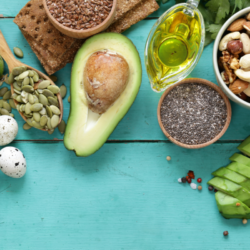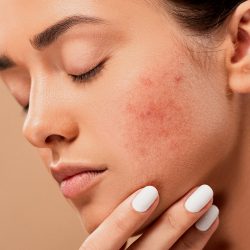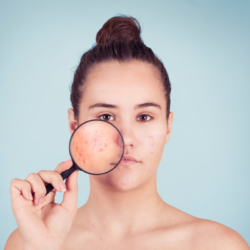The role of perspiration is to ensure thermal regulation in order to maintain body temperature at 37°C.Hyperhidrosis occurs when the amount of sweat produced significantly exceeds that required for thermoregulation. Excessive sweatingor hyperhidrosis is the excessive production of sweat. It seriously impairs the quality of life of sufferers.
What is hyperhidrosis?
Hyperhidrosis is a pathology responsible for the excessive production of sweat, which currently affects 1 in 4 French people. The dermis is made up of highly vascularised fibrous elastic tissue whose role is to protect and nourish the epidermis. The dermis contains sweat glands and sebaceous glands. The sweat glands are responsible for eliminating waste products through sweat at a rate of 1 litre per day.
There are 2 types of sweat glands:
Apocrine glands :
Located under the armpits and in the genital, anal and umbilical areas, they produce sweat for sexual purposes. They predominate in the axillary and genital areas. Apocrine glands produce an odourless liquid which decomposes under the influence of bacteria and acquires an unpleasant, characteristic odour.
Eccrine glands :
Located throughout the rest of the body, they produce elimination sweat. They are distributed throughout the body, with the greatest abundance on the palms of the hands, soles of the feet and armpits (axillary region). Eccrine glands play an important role in regulating body temperature. Under stress or heat, the eccrine glands can secrete up to 10 litres of sweat a day. Sweating (eccrine) is a normal response to increased body temperature(heat, exercise, fever) and emotion.
The production and excretion of sweat depend on the sympathetic nervous system and are regulated by the hypothalamus (a gland located in the brain).
Role of the hypothalamus
The hypothalamus, a part of the brain, plays a key role in regulating body temperature and, consequently, in sweat production. It detects variations in body temperature and sends signals to the sweat glands via the sympathetic nervous system.
Influence of hormones
Certain hormones, such as adrenaline and noradrenaline, can also influence sweat production. During a “fight or flight” response, these hormones increase, leading to increased sweating.
Sweat cooling function
Sweat plays a vital role in cooling the body. When sweat evaporates from the surface of the skin, it carries heat with it, helping to lower body temperature.
Emotional reactions and perspiration
Emotional reactions, such as anxiety or fear, can also trigger sweating. This type of sweating, often concentrated in the palms, feet and armpits, is linked to the activity of the sympathetic nervous system in response to emotions.
What causes hyperhidrosis?
A distinction is made between primary or essential hyperhidrosis (with no recognised cause) and hyperhidrosis secondary to disease. In the event of generalised hyperhidrosis or hyperhidrosis localised in an unusual area (other than the palms, soles or armpits), it is essential to consult a doctor to investigate the cause, especially if the excessive sweating has occurred recently.
Essential hyperhidrosis is thought to be secondary to excessive functioning of the reflex circuits involved in eccrine sweating. It often begins at puberty, peaks between the third and fourth decades of life and then declines with age. Palmoplantar hyperhidrosis (of the feet and hands) predominates in men. Hyperhidrosis is usually intermittent and increased by stress. A vicious circle is often formed, as excessive sweating of the hands or armpits is often embarrassing and generates stress that increases it.
Hyperhidrosis can also be the consequence of other pathologies such as the menopause,obesity, diabetes or hyperthyroidism.
Genetic predisposition to hyperhidrosis
Primary hyperhidrosis is a condition where a person sweats excessively for no apparent reason. This form of hyperhidrosis is often linked to genetics, as shown by the frequency of similar cases in the families of sufferers.
Understanding the genetic transmission of hyperhidrosis
Scientific studies suggest that primary hyperhidrosis can be inherited in an autosomal dominant or recessive fashion. In simple terms, this means that the condition can be passed from parents to children through a single gene (dominant) or that it requires a specific pair of genes (recessive) to manifest itself. However, the exact genetic locations, or ‘loci’, associated with primary hyperhidrosis vary and are not always consistent from study to study.
Identification of candidate genes
Some research has identified specific regions on chromosomes that may be linked to hyperhidrosis. For example, one study suggested a link with chromosome 14q11.2-q13, but this finding has not been consistently confirmed. Other studies have identified potential genes on chromosome 2q22.1-q31.1. Further genetic analysis has revealed four significant loci, in line with previous findings, but the results should be interpreted with caution.
Exploring pathogenic mechanisms
A number of hypotheses have been put forward concerning the mechanisms that cause primary hyperhidrosis. For example, a significant quantity of the AQP5 protein has been found in the cells of the sweat glands in sufferers, although the genetic links with the AQP5 gene are not clearly established. Other genes, such as PLB1, PPP1CB, NDR2 and ABC11, are also considered potential candidates. Interestingly, some hereditary hyperhidrosis disorders are associated with specific chromosomes, such as nail-rot syndrome linked to chromosome 9.
Challenges in analysing genetic data
The analysis of genetic data is complex due to the variability of the methods used to classify hyperhidrosis, different measurements, the review of medical records, as well as surveys and interviews. The recollections of interviewees can also introduce bias into the results.
Perspectives on the genetics of hyperhidrosis
In conclusion, current genetic research indicates a wide diversity in the causes of hyperhidrosis, suggesting that it is a multifactorial condition. To obtain a more in-depth understanding of hyperhidrosis and its genetic links, further studies on larger groups of patients are required.
Some naturopathic advice to limit hyperhidrosis
- Avoid alcohol, tobacco, foods containing caffeine (coffee, tea, chocolate or caffeine-based soft drinks) and spicy foods, acid or peanut butter, as they stimulate the production of sweat
- Wash the areas prone to hyper-perspiration with a mild soap 1 or 2 times a day, drying well to avoid maceration, which could encourage the appearance of fungus
- Choose loose-fitting clothes made from natural materials (cotton, linen, wool) rather than synthetics. For example, change cotton socks twice a day if necessary, and wear leather or canvas shoes rather than plastic ones
- Hair removal also reduces the adhesion of sweat to the hair
- Learn to control stressful situations: relaxation techniques, for example
- Use a deodorant or anti-perspirant
- Remember to drink plenty of water to counteract possible dehydration
In the case of profuse and/or intense perspiration: use an anti-perspirant (spray with alcohol, roll-on bottle), taking care not to irritate sensitive skin. These anti-perspirant products are often applied in the evening as part of a course of treatment lasting a few days
Are there any natural treatments to combat excessive perspiration?
There are antiperspirant plants that can be used to combat excessive sweating, but there are also sweat-inducing plants that should be avoided, such as burdock, lemon balm, wild pansy, borage, plantain, elderberry or violet..
Among the plants used to treat hyperhidrosis, external decoctions of horsetail, cypress and sage are particularly effective on the feet (local baths). A number of essential oils can also be used for their anti-odour effects to regulate excessive perspiration: Scots pine, Ceylon citronella, clary sage and palmarosa essential oils.
Homeopathy can also play a role in significant water loss, namely China rubra 9CH, 5 granules 3 or 4 times a day.
Managing hyperhidrosis through diet
Hyperhidrosis, or excessive sweating, can be an embarrassing and uncomfortable problem for some people. While there is no specific diet to treat hyperhidrosis, there are foods that can help reduce sweat production and improve overall health. Here are some tips for a healthy diet that can help reduce hyperhidrosis:
- Avoid spicy foods: spicy foods can stimulate sweat production and worsen hyperhidrosis symptoms.
- Limit caffeine: Caffeine can also stimulate sweat production. Try to limit your intake of coffee, tea and energy drinks.
- Increase your intake of fruit and vegetables: fruit and vegetables are rich in antioxidants and nutrients that help regulate sweat production and improve overall health.
- Drink enough water: dehydration can make hyperhidrosis worse. Make sure you drink enough water throughout the day.
- Avoid processed foods: processed foods often contain additives that can stimulate sweat production. Try to eat fresh, unprocessed foods as much as possible.
With the return of warmer weather and the gradual rise in outdoor temperatures, sweating is not inevitable, and there are solutions to excessive perspiration! Don’t let halos, sweaty hands or unpleasant body odour spoil your life!
The importance of hydration
Hydration is a crucial element in controlling hyperhidrosis. Adequate hydration can play a significant role in regulating body temperature and therefore reducing excessive sweating.
Recommended water intake
Experts recommend drinking at least 8 glasses of water a day, which is equivalent to around 2 litres. This amount may vary according to individual factors such as weight, level of physical activity and climate. For people suffering from hyperhidrosis, it is particularly important to maintain constant hydration, as the loss of fluids due to perspiration must be compensated for.
Monitoring hydration
A simple way to monitor your hydration is to pay attention to the colour of your urine. Clear or straw-coloured urine is an indicator of good hydration, while dark urine may mean you need to drink more water. It’s also advisable to drink water regularly throughout the day, rather than consuming large quantities all at once.
Water and body temperature
Water helps regulate body temperature. When dehydrated, the body has difficulty maintaining a normal temperature, which can lead to increased sweating to compensate. Good hydration can help stabilise body temperature and reduce excessive sweating.
The importance of pure water
Although it’s tempting to turn to sugary or caffeinated drinks, pure water is the best option for hydration. Sugary drinks can lead to blood sugar spikes, which in turn can increase sweating. Similarly, caffeine is a diuretic, which can lead to fluid loss and worsen hyperhidrosis.
Water-rich foods
As well as drinking water, eating water-rich foods can also contribute to hydration. Foods such as cucumbers, watermelon, oranges and strawberries are not only hydrating, but also provide essential vitamins and minerals.
Medical literature and clinical trials:
- Benohanian A. Antiperspirants and Deodorants. Clin Dermatol. 2001
- Sandrine Nail-Billaud: Excessive perspiration; how to prevent it-how to treat it. 2020
- Dermatol Ther (Heidelb). 2023 Feb; Hyperhidrosis: A Central Nervous Dysfunction of Sweat Secretion







